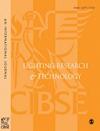使用CIE S 026黑视度量法研究室内环境中的日光光谱
IF 2.2
3区 工程技术
Q2 CONSTRUCTION & BUILDING TECHNOLOGY
引用次数: 1
摘要
自发现内在光敏视网膜神经节细胞(ipRGCs)及其对昼夜节律的影响以来,许多学科都在研究光对人类生理和心理的影响。然而,关于房间的空间结构(方向和凝视方向)如何改变光线质量和数量的研究并不多。这项研究考察了自然光照光谱的可变性,重点是光强度、光谱本身,以及季节和时间的变化。所检查的指标是CIE S 026黑视等效日光照度(黑视EDI)和黑视日光效率比(黑视DER)。现场测量是在塞浦路斯一间朝南的房间里使用光谱仪进行的。研究的主要参数为8个注视方向、4个季节(6月、9月、12月、3月)和每天4个不同时段(09:00、12:00、15:00、18:00),共20个位置。结果显示季节、时间和凝视方向对黑视DER和黑视EDI的影响。总体而言,由于冬季低太阳角度和阳光直射,黑视性EDI明显高于其他三个季节,而黑视性DER值最低。在所有季节和时间,大多数病例都达到了建议的最低黑视性EDI白天光照超过250 lx。本文章由计算机程序翻译,如有差异,请以英文原文为准。
Investigation of the daylight spectrum in an indoor environment using CIE S 026 melanopic metrics
Since discovering the intrinsically photosensitive retinal ganglion cells (ipRGCs) and their impact on the circadian rhythm, many disciplines have been researching the physiological and psychological effects of light on humans. However, not much research has been conducted on how the spatial configuration of a room (orientation and gaze direction) changes the light quality and quantity. This research examines the variability of the natural lighting spectrum, focusing on light intensity, the spectrum itself, as well as variations across seasons and hours. The metrics examined are the CIE S 026 melanopic equivalent daylight illuminance (melanopic EDI) and melanopic daylight efficacy ratio (melanopic DER). Field measurements were taken in a room with a south orientation located in Cyprus, using a spectrometer. The main parameters under study were eight gaze directions, four seasons (June, September, December and March) and four different hours each day (09:00, 12:00, 15:00 and 18:00) for 20 positions in the test room. The results show the impact of season, time and gaze direction on the melanopic DER and melanopic EDI. Overall, due to the low sun angle and direct sunlight exposure in the winter, the melanopic EDI was much higher compared to the other three seasons, whereas the melanopic DER had the lowest values. For all seasons and times, most of the cases achieved the minimum recommendation for daytime light exposure of melanopic EDI of more than 250 lx.
求助全文
通过发布文献求助,成功后即可免费获取论文全文。
去求助
来源期刊

Lighting Research & Technology
工程技术-光学
CiteScore
5.40
自引率
16.00%
发文量
69
审稿时长
>12 weeks
期刊介绍:
Lighting Research & Technology (LR&T) publishes original peer-reviewed research on all aspects of light and lighting and is published in association with The Society of Light and Lighting. LR&T covers the human response to light, the science of light generation, light control and measurement plus lighting design for both interior and exterior environments, as well as daylighting, energy efficiency and sustainability
 求助内容:
求助内容: 应助结果提醒方式:
应助结果提醒方式:


